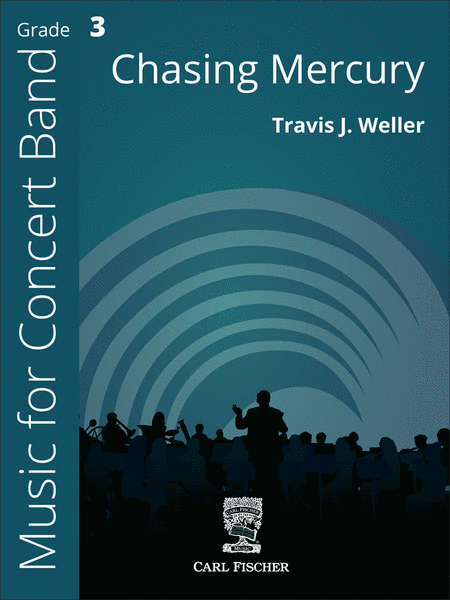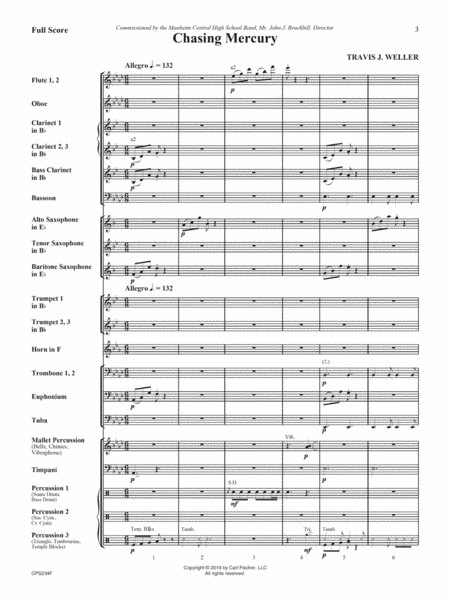Details
Description
SKU: CF.CPS234
Composed by Travis Weller. Folio. Cps. Set of Score and Parts. 8+8+4+8+8+8+4+4+8+4+4+8+8+8+8+6+6+6+4+8+6+2+4+4+6+32 pages. Duration 3 minutes, 10 seconds. Carl Fischer Music #CPS234. Published by Carl Fischer Music (CF.CPS234).ISBN 9781491156346. UPC: 680160914883. 9 x 12 inches.
Mercury - the Roman god of financial gain, commerce, travelers, boundaries, luck, trickery, merchants, and thieves. A popular deity in Roman culture, he was instantly recognized by his unique winged shoes (talaria) and hat (petasos). With its close proximity to the sun and faster orbit than all other planets, the Romans named this small celestial body after the swift-winged messenger of their culture. It is not surprising that in Holst's major orchestral suite The Planets that Mercury utilizes such light and swift themes. There is some duality to the title of the work. Part of it involves my impression of what a playful chase of the winged messenger sounds like. The other part is the opening motif chasing two themes of Holst around the rest of the work. It was only after developing the first few ideas that I recognized some of the commonalities with some of those same themes from Holst's orchestral work. There are several quotations from that famous piece by Holst (notably as both are stated successively at mm. 13-20). The idea of someone having to chase the Winged Messenger struck me as a unique title around which to craft a work. One of my core beliefs about music is that it can be imbued with meaning by a composer, and as the sonic story unfolds an ensemble, director, and audience members can draw out their own meaning from the experience. Who exactly is chasing Mercury? I leave that up to the wonderfully creative minds of the young ladies and gentlemen who have the opportunity to bring this work to life. The opportunity to compose music and allow student musicians to give this piece new life and draw out different meanings is a humbling experience. Rehearsal Notes and Suggestions As stated earlier, the opening motif (a range of a seventh) comes back frequently in the work in a variety of settings and textures. Throughout the work, it is important for students to recognize the two themes from Holst when they are present in the sound canvas. If the solos (clarinet and alto saxophone) are utilized, the supporting parts around and underneath those lines must be sensitive and play in such a way to properly balance those parts. There are number of muted sections for the trumpet section, and I would advocate for all trumpets acquiring the same mute to contribute to unity in timbre. The bold fanfare sections (the first occurs at m. 37) must be presented with a unified articulation style. As the texture intensifies prior to m. 169, it is crucial for the ensemble to play within themselves and exercise musical courtesy to allow all voices to be heard as they arrive at m. 181. My thanks in advance for your support of this music, and I wish you well as you and your ensemble begin Chasing Mercury!.
Mercury – the Roman god of financial gain, commerce, travelers, boundaries, luck, trickery, merchants, and thieves. A popular deity in Roman culture, he was instantly recognized by his unique winged shoes (talaria) and hat (petasos). With its close proximity to the sun and faster orbit than all other planets, the Romans named this small celestial body after the swift-winged messenger of their culture. It is not surprising that in Holst’s major orchestral suite The Planets that Mercury utilizes such light and swift themes.There is some duality to the title of the work. Part of it involves my impression of what a playful chase of the winged messenger sounds like. The other part is the opening motif chasing two themes of Holst around the rest of the work. It was only after developing the first few ideas that I recognized some of the commonalities with some of those same themes from Holst’s orchestral work. There are several quotations from that famous piece by Holst (notably as both are stated successively at mm. 13–20). The idea of someone having to chase the Winged Messenger struck me as a unique title around which to craft a work.One of my core beliefs about music is that it can be imbued with meaning by a composer, and as the sonic story unfolds an ensemble, director, and audience members can draw out their own meaning from the experience. Who exactly is chasing Mercury? I leave that up to the wonderfully creative minds of the young ladies and gentlemen who have the opportunity to bring this work to life. The opportunity to compose music and allow student musicians to give this piece new life and draw out different meanings is a humbling experience.Rehearsal Notes and SuggestionsAs stated earlier, the opening motif (a range of a seventh) comes back frequently in the work in a variety of settings and textures. Throughout the work, it is important for students to recognize the two themes from Holst when they are present in the sound canvas. If the solos (clarinet and alto saxophone) are utilized, the supporting parts around and underneath those lines must be sensitive and play in such a way to properly balance those parts. There are number of muted sections for the trumpet section, and I would advocate for all trumpets acquiring the same mute to contribute to unity in timbre. The bold fanfare sections (the first occurs at m. 37) must be presented with a unified articulation style. As the texture intensifies prior to m. 169, it is crucial for the ensemble to play within themselves and exercise musical courtesy to allow all voices to be heard as they arrive at m. 181. My thanks in advance for your support of this music, and I wish you well as you and your ensemble begin Chasing Mercury!


 Share
Share